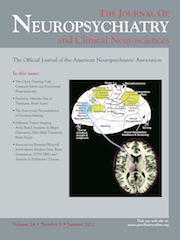Olfactory Reference Syndrome: An Unusual Delusion in a Patient With Parkinson’s Disease
To the Editor: Delusions and hallucinations, including olfactory hallucinations, are frequent in the course of Parkinson’s disease (PD).1 However, an olfactory reference syndrome (ORS), a delusional disorder in which individuals believe they emit a foul body odor,2,3 has not been reported in this setting.
Case Report
The patient, a 59-year-old woman, had a history of postpartum depression at age 29. About 20 years before PD onset she had experienced pruritus and was briefly convinced she had scabies, although physicians discarded this diagnosis. She was diagnosed with PD at age 53. First-line treatment with piribedil, a dopaminergic agonist, was effective. Levodopa (plus carbidopa) was added 3 years later, and entacapone was added when a wearing-off effect developed. Her motor status has since remained fair (8 years after onset). One year after onset of PD, while on piribedil monotherapy, the patient experienced a transient hypomanic state with increased libido, and reported having masturbated with ice cubes. Shortly afterward, she complained of foul odors that she attributed to her vaginal secretions. This conviction gradually became stronger, and she started to suspect that her gut was also responsible. The patient was convinced that other people showed expressions of disgust or made covert comments, and she showed social avoidance. She transiently developed depressive symptoms, without fulfilling DSM-IV criteria for a major episode. She had anxiety with obsessional features but no compulsion. There were no other associated psychotic disorders, with the exception of transient visual hallucinations in dim light with preserved insight. Olfactory function, assessed with the 12-item Brief Smell Identification Test (Sensonics) was normal. Neuropsychological status, assessed with the Mattis Dementia Rating Scale, Frontal Assessment Battery, verbal fluencies tests, and a free and cued recall performance test, was normal. MRI of the brain was normal. The ORS was unaffected by the addition of clozapine (maximum daily dose 125 mg) and paroxetine (30 mg). Piribedil was withdrawn, the antiparkinsonian treatment consisting only in levodopa 100 mg/carbidopa 25 mg/entacapone 200 mg tid. This change had no effect on the ORS, which was still present 7 years after its onset.
Discussion
Delusions, commonly of a paranoid nature, affect 1%–7% of PD patients1 and are more common in PD patients with dementia. In the present case, the dopaminergic agonist had a triggering role, and was also responsible for the hypersexuality as previously described4 However, several atypical features were present: the early onset (within 1 year of diagnosis); the lack of cognitive impairment; the dissociation from dopaminergic treatment dose, whereas in other reported cases, an isolated delusional syndrome resolved when dopaminergic-agonist therapy was reduced or withdrawn5; the lack of response to clozapine or serotonin reuptake inhibitors2; and the possible association with premorbid vulnerability to psychosis, as suggested by the distant episode of probable delusional parasitosis (the alleged scabies). ORS should thus be added to the list of possible, although rare, psychotic syndromes observed in the course of PD. Premorbid susceptibility may contribute to the onset of some delusional disorders in this setting,5 with a triggering role of dopaminergic agents.
1 : Epidemiology of psychosis in Parkinson’s disease. J Neurol Sci 2010; 289:12–17Crossref, Medline, Google Scholar
2 : Olfactory reference syndrome. Psychosomatics 2008; 49:77–81Crossref, Medline, Google Scholar
3 : Olfactory reference syndrome: issues for DSM-V. Depress Anxiety 2010; 27:592–599Crossref, Medline, Google Scholar
4 : Impulsive and compulsive behaviors in Parkinson’s disease. Mov Disord 2009; 24:1561–1570Crossref, Medline, Google Scholar
5 : Isolated delusional syndrome in Parkinson’s Disease. Parkinsonism Relat Disord 2010; 16:550–552Crossref, Medline, Google Scholar



